|
|
|
Sort Order |
|
|
|
Items / Page
|
|
|
|
|
|
|
| Srl | Item |
| 1 |
ID:
162410


|
|
|
|
|
| Summary/Abstract |
The Black Saturday massacre that took place on 6 December 1975 in Beirut, Lebanon, marked the first large-scale targeting of Lebanese civilians during the Lebanese civil war. The magnitude of the violence committed on that day set the precedent to outbursts of violence between December 1975 and June 1976, namely the Battle of the Hotels, and the Karantina and Damour massacres which were retaliatory in nature. The circumstances surrounding the massacre remain tied to one individual in particular, Joseph Sa`adeh, who initiated the massacre upon learning of the death of his son. Considering that the construction of the Lebanese civil war narrative remains one of the most politically contested and sensitive processes in Lebanon to date, this article examines where personal motivations, grievances and convictions fit in historiographical practices, which are often centred on actions themselves, and are dismissive of the vast personal negotiations that build up to them. The article therefore offers a deeper examination of Lebanese civil war historiography, by stitching together the voices of both fighters and civilians. In doing so, the article also challenges the linear trajectories of war narratives in Lebanon that lend themselves easily to epistemological labels of sectarianism, and often ignore the arbitrariness of people's behaviour in times of extreme stress.
|
|
|
|
|
|
|
|
|
|
|
|
|
|
|
|
| 2 |
ID:
171303
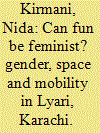

|
|
|
|
|
| Summary/Abstract |
The densely populated, multi-ethnic area of Lyari in Karachi is one of the city’s original settlements. The area has become infamous as the site of an ongoing conflict between criminal gangs, political parties and law enforcement agencies for over a decade, and, for this reason, Lyari has been labelled as one of several ‘no-go areas’ in the city. However, for the residents of Lyari, the ways in which they understand their part of the city far exceed these facile labels. While at times their neighbourhoods do become fearful spaces, they are also places of comfort, familiarity and fun. This article explores the multiple ways in which women and girls experience and understand this area. In particular, it documents the various ways in which they express and experience enjoyment in their everyday lives and during exceptional moments. Based on extensive interviews and participant observation in several neighbourhoods, the research shifts attention away from solely using violence as a lens to understand urban space and away from seeing women mainly as victims of violence. Focusing on the pursuit of fun and enjoyment as an area of academic inquiry can be an important way to show how women push against and challenge patriarchal boundaries. By highlighting women’s and girls’ own creative navigations and engagements with their locality and the city, this paper brings new insights into discussions of gender and urban marginalisation more generally.
|
|
|
|
|
|
|
|
|
|
|
|
|
|
|
|
| 3 |
ID:
154065
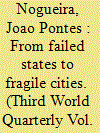

|
|
|
|
|
| Summary/Abstract |
It has become commonplace to claim that cities are becoming conflict zones, or ‘war zones’. This article traces some of the discursive and conceptual shifts that made it possible to define the city as a new frontier for international humanitarian action in states of the Global South. In order to represent cities as humanitarian spaces, concepts of ‘failure’ and ‘fragility’ have been problematised and subjected to reinterpretations that legitimised new strategies applied to the urban realm. I argue that this re-scaling of humanitarian practices enables a de-coupling and inclusion of so called new ‘urban conflicts’ in strategies of global liberal governance. Moving from failed states to fragile cites is a key development to understand changes in the practices that redefine humanitarian spaces today. The definition of urban violence as a new type of conflict informs a new cycle of expansion of the humanitarian order focused on the city. The article analyses the problematisation of concepts of failure and fragility as a decisive move to redefine the boundaries of humanitarian spaces.
|
|
|
|
|
|
|
|
|
|
|
|
|
|
|
|
| 4 |
ID:
120936


|
|
|
|
|
| Publication |
2013.
|
| Summary/Abstract |
By now, ensuring Good Urban Governance (GUG) has been one of the major challenges for urban government in the developing countries. Though the main objective of GUG is to ensure equal facilities to urban people, in most cases, it is not materialised. One of the reasons is lack of proper urban planning and management, which by and large, results in unplanned growth of slums and illegal settlement. Due to rapid migration of people from rural to urban areas, urban governments are facing numerous challenges to meet the basic needs of urban people. The rapid inflow of additional people creates extra pressure on water, housing, electricity, gas and other means of survival. This has also instigated various social, political, institutional, economic and structural forms of violence in the cities. At present, urban governments of many developing countries have failed to tackle various forms of crimes and delinquencies. This raises the important query as to how GUG is interlinked with urban security issues? It is in this context that the major objectives of the paper are to perceive the overall phenomenon and outline the various dimensions of urban insecurity issues in relations with the GUG. Based on the evidences of violent activities in different cities, some key challenges of urban government have been discussed. Deriving the causes and consequences of urban violence, some recommendations have been put forward from developing country context.
|
|
|
|
|
|
|
|
|
|
|
|
|
|
|
|
| 5 |
ID:
098818
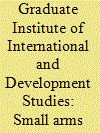

|
|
|
|
|
| Publication |
Cambridge, Cambridge University Press, 2009.
|
| Description |
vii, 344p.
|
| Standard Number |
9780521880411, hbk
|
|
|
|
|
|
|
|
|
|
|
|
Copies: C:1/I:0,R:1,Q:0
Circulation
| Accession# | Call# | Current Location | Status | Policy | Location |
| 055210 | 355.8205/GRA 055210 | Main | On Shelf | Reference books | |
|
|
|
|
| 6 |
ID:
134171
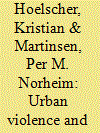

|
|
|
|
|
| Publication |
2014.
|
| Summary/Abstract |
Despite problems of violence domestically, Brazil has played a key leadership role as part of MINUSTAH peacekeeping operations in Haiti since 2004. This article addresses how Brazil's international military engagement is shaping domestic approaches to urban security, and what may be the implications of the use of military strategies, operations, and norms to address issues of public security in Brazilian cities. It is argued that current approaches toward urban security employing military-trained peacekeepers actually represent a continuation of old paradigms, yet these recent militarised approaches are likely evolving into newer and potentially more accountable forms by constraining indiscriminate use of force and establishing a positive state presence in marginal urban areas. As such, the article connects long-established issues of dealing with urban violence in Latin America with ongoing debates in the United States and beyond about post-counterinsurgency approaches to increasingly urban conflict settings. It reflects on potential lessons to be learned from the Latin American perspective, while showing also how these have changed over the last decade. The article concludes that despite the potential utility of force in some urban conflict settings, this approach could entail a normative shift towards legitimising forceful containment of violence, and hinder democratic consolidation in Brazil.
|
|
|
|
|
|
|
|
|
|
|
|
|
|
|
|
| 7 |
ID:
137789
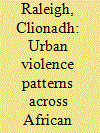

|
|
|
|
|
| Summary/Abstract |
This analysis of urban political violence across Africa considers why the proportion and frequency of conflict is increasing in urban areas while decreasing in rural areas. The decline of formally organized violence in predominantly rural areas, and the increase of more variegated forms of political opposition and conflict in urban zones, is interrogated through demographic and grievance-based explanations. Urban violence displays a range of agents, goals, intensities, and triggers and is alternatively regarded as a response to the lack of capacity and poor governance found in urban contexts, or to the changing demographic and political character of African states. Yet, the multiple, low-intensity forms of urban violence present—including militia attacks, communal contests, riots, and protests—indicate a change in the collective action capabilities and goals of modern conflict agents. These goals are themselves shaped by the experience of mounting urban grievances, but the ethnic and regional heterogeneity in urban areas prevents substantial collective action to counter the urban marginalization practiced by many African governments. Despite the low-intensity nature of urban threats, this compounded violence is a substantial security threat across developing states and is leading to the rise of the “fragile city.”
|
|
|
|
|
|
|
|
|
|
|
|
|
|
|
|
|
|
|
|
|